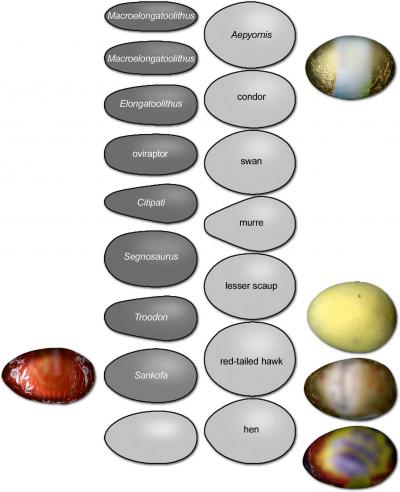Research by paleontologists in Spain and the UK suggests that not all Easter eggs come from the same 'parent' species; some could be from dinosaurs, including a new species from the Pyrenees.
Scientists investigating whether 70 million-year-old fossil eggs found in the Pyrenees were laid by birds, or their dinosaur ancestors, have published their findings in the current issue of the journal Palaeontology.
And researchers from the University of Leicester have extended the study further by comparing Easter egg shapes to those of birds' and dino eggs.
The authors of the Pyrenees research, Nieves Lopez-Martinez of the Universidad Complutense of Madrid and Enric Vicens of the Universitat Autonoma of Barcelona, compared the shape of the fossil eggs with various dinosaur and modern bird eggs:
"We found that different species have different shaped eggs, and that the eggs of dinosaurs are not the same shape as the eggs of birds," said Enric Vicens.
In the scientific analysis, a mathematical formula was used to determine and describe all possible egg shapes, and real eggs were then plotted into this "egg morphospace"; in simple terms, as Vicens points out "dinosaur eggs tend to be more elongate and less rounded than birds eggs.
"Dinosaur eggs also tend to be more symmetrical with less distinction between the blunt and the more pointed end," Vicens added.
A small additional project carried out at the University of Leicester in the UK reveals that Easter egg shape varies considerably more than would be expected if they all came from the same parent species.
 The pale gray eggs are from birds, the darker gray eggs are from dinosaurs. Most Easter eggs, as shown on the right, are similar in shape to bird's eggs, but some are closer to the eggs of dinosaurs. The Easter egg on the left is particularly close to the newly described egg Sankofa. Credit: Mark Purnell, University of Leicester
The pale gray eggs are from birds, the darker gray eggs are from dinosaurs. Most Easter eggs, as shown on the right, are similar in shape to bird's eggs, but some are closer to the eggs of dinosaurs. The Easter egg on the left is particularly close to the newly described egg Sankofa. Credit: Mark Purnell, University of Leicester
"Many of the smaller eggs to be found commonly on the UK High Street are very similar in shape to hen's eggs, providing strong clues to their original source. Others are more similar in shape to Condor eggs.
"Perhaps more surprisingly a few eggs are closer in shape to those of dinosaurs, with one in particular being the same shape as the 70 million year old dinosaur egg, Sankofa pyrenaica, described by the Spanish team".
According to Professor Darla Zelenitsky of the University of Calgary, "Palaeontologists have long suggested that small early mammals might have raided the nests of dinosaurs. Generally, the idea is that they stole the eggs for food, but if the evidence of this Easter egg research is reliable, perhaps early mammals had more playful and colourful motives."
Source: University of Leicester

The aim of art is to represent not the outward appearance of things, but their inward significance. – Aristotle
















